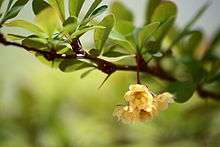Berberis thunbergii
| Berberis thunbergii | |
|---|---|
 | |
| Berberis thunbergii shoot with fruit | |
| Scientific classification | |
| Kingdom: | Plantae |
| Clade: | Angiosperms |
| Clade: | Eudicots |
| Order: | Ranunculales |
| Family: | Berberidaceae |
| Genus: | Berberis |
| Species: | B. thunbergii |
| Binomial name | |
| Berberis thunbergii | |
Berberis thunbergii, the Japanese barberry, Thunberg's barberry, or red barberry,[1] is a species of flowering plant in the barberry family, Berberidaceae, native to Japan and eastern Asia, though widely naturalized in China and in North America.[2][3][4] Growing to 1 metre (3.3 ft) tall by 2.5 metres (8.2 ft) broad, it is a small deciduous shrub with green leaves turning red in the autumn, brilliant red fruits in autumn and pale yellow flowers in spring. Numerous cultivars are available as ornamental plants suitable for hedging.[5]
Description
B. thunbergii has deeply grooved, brown, spiny branches with a single (occasionally tridentine) spine (actually a highly modified leaf) at each shoot node. The leaves are green to blue-green (reddish or purple in some horticultural variants), very small, spatula to oval shaped, 12–24 mm long and 3–15 mm broad; they are produced in clusters of 2–6 on a dwarf shoot in the axil of each spine. The flowers are pale yellow, 5–8 mm diameter, produced in drooping 1–1.5 cm long umbrella-shaped clusters of 2–5; flowering is from mid spring to early summer. The edible fruit is a glossy bright red to orange-red, ovoid berry 7–10 mm long and 4–7 mm broad, containing a single seed. They mature during late summer and fall and persist through the winter.[4]
Identification
This species is sometimes confused with Berberis canadensis (American barberry), Berberis vulgaris (European barberry), and other deciduous Berberis species; it is most readily distinguished by the flowers being produced in umbels, not racemes.
Cultivation

Berberis thunbergii is widely grown as an ornamental plant,[6] both in Japan and elsewhere in the temperate Northern Hemisphere. Numerous cultivars have been selected, including plants selected for yellow, dark red to violet, or variegated foliage, erect growth (for hedge use), and dwarf size.
In cultivation in the UK, the following have gained the Royal Horticultural Society's Award of Garden Merit:
- B. thunbergii 'Fireball'[7]
- B. thunbergii 'Maria'[8]
- B. thunbergii f. atropurpurea 'Admiration'[9]
- B. thunbergii f. atropurpurea 'Atropurpurea Nana'[10]
- B. thunbergii f. atropurpurea 'Concorde'[11]
- B. thunbergii f. atropurpurea 'Dart's Red Lady'[12]
- B. thunbergii f. atropurpurea 'Golden Ring'[13]
- B. thunbergii f. atropurpurea 'Harlequin'[14]
- B. thunbergii f. atropurpurea 'Rose Glow'[15]
Invasive species
In recent years, Berberis thunbergii has been recognized as an invasive species in many parts of the eastern United States.[4] The Plant Conservation Alliance's Alien Plant Working Group lists it among its "Least Wanted".[16] Japanese barberry is prohibited from being a seed contaminant in Michigan and banned from sale in Massachusetts.[17]
This Berberis is avoided by deer, and has been replacing native species. Furthermore, the plant can raise the pH of the soil and affect soil nitrogen levels. Unlike B. canadensis and B. vulgaris, B. thunbergii does not act as a host for Puccinia graminis (black rust), a rust disease of wheat.[4]
It is also an exceptionally favorable environment for ticks due to the high humidity present in barberry's dense foliage. It is hypothesized that spread of barberry is correlated with the spread of Lyme disease.[18]
Gallery
 Cultivar 'Aurea'
Cultivar 'Aurea' Cultivar 'Atropurpurea'
Cultivar 'Atropurpurea' Naturalized Berberis thunbergii in Penwood State Park in Connecticut
Naturalized Berberis thunbergii in Penwood State Park in Connecticut- Leaves
- Leaf
References
- ↑ "Moonshine Designs Nursery". Archived from the original on 2 April 2008. Retrieved 29 March 2008.
- ↑ "Berberis thunbergii in Flora of China @ efloras.org". www.efloras.org.
- ↑ "Berberis thunbergii in Flora of North America @ efloras.org". www.efloras.org.
- 1 2 3 4 Swearingen, Jil M. (7 July 2009). "Least Wanted: Japanese Barberry". U.S. National Park Service. Retrieved 20 March 2011.
- ↑ Brickell, Christopher, ed. (2008). The Royal Horticultural Society A-Z Encyclopedia of Garden Plants. United Kingdom: Dorling Kindersley. ISBN 9781405332965.
- ↑ "RHS Plant Selector – Berberis thunbergii". Retrieved 12 June 2013.
- ↑ "RHS Plantfinder – Berberis thunbergii 'Fireball'". Royal Horticultural Society. Retrieved 21 January 2018.
- ↑ "RHS Plantfinder – Berberis thunbergii 'Maria'". Royal Horticultural Society. Retrieved 21 January 2018.
- ↑ "RHS Plantfinder – Berberis thunbergii f. atropurpurea 'Admiration'". Royal Horticultural Society. Retrieved 21 January 2018.
- ↑ "RHS Plantfinder – Berberis thunbergii f. atropurpurea 'Atropurpurea Nana'". Royal Horticultural Society. Retrieved 21 January 2018.
- ↑ "RHS Plantfinder – Berberis thunbergii f. atropurpurea 'Concorde'". Royal Horticultural Society. Retrieved 21 January 2018.
- ↑ "RHS Plantfinder – Berberis thunbergii f. atropurpurea 'Dart's Red Lady'". Royal Horticultural Society. Retrieved 21 January 2018.
- ↑ "RHS Plantfinder – Berberis thunbergii f. atropurpurea 'Golden Ring'". Royal Horticultural Society. Retrieved 21 January 2018.
- ↑ "RHS Plantfinder – Berberis thunbergii f. atropurpurea 'Harlequin'". Royal Horticultural Society. Retrieved 21 January 2018.
- ↑ "RHS Plantfinder – Berberis thunbergii f. atropurpurea 'Rose Glow'". Royal Horticultural Society. Retrieved 21 January 2018.
- ↑
- ↑ "Berberis thunbergii". USDA plant database. Retrieved 8 November 2015.
- ↑ Zimmer, Carl (30 April 2013). "The Rise of the Tick".
External links
| Wikimedia Commons has media related to Berberis thunbergii. |
- US National Park Service: Berberis thunbergii (deals with the species as an invasive species)
- Native Wildlife Garden (concerning lyme disease in relation to barberry stands)